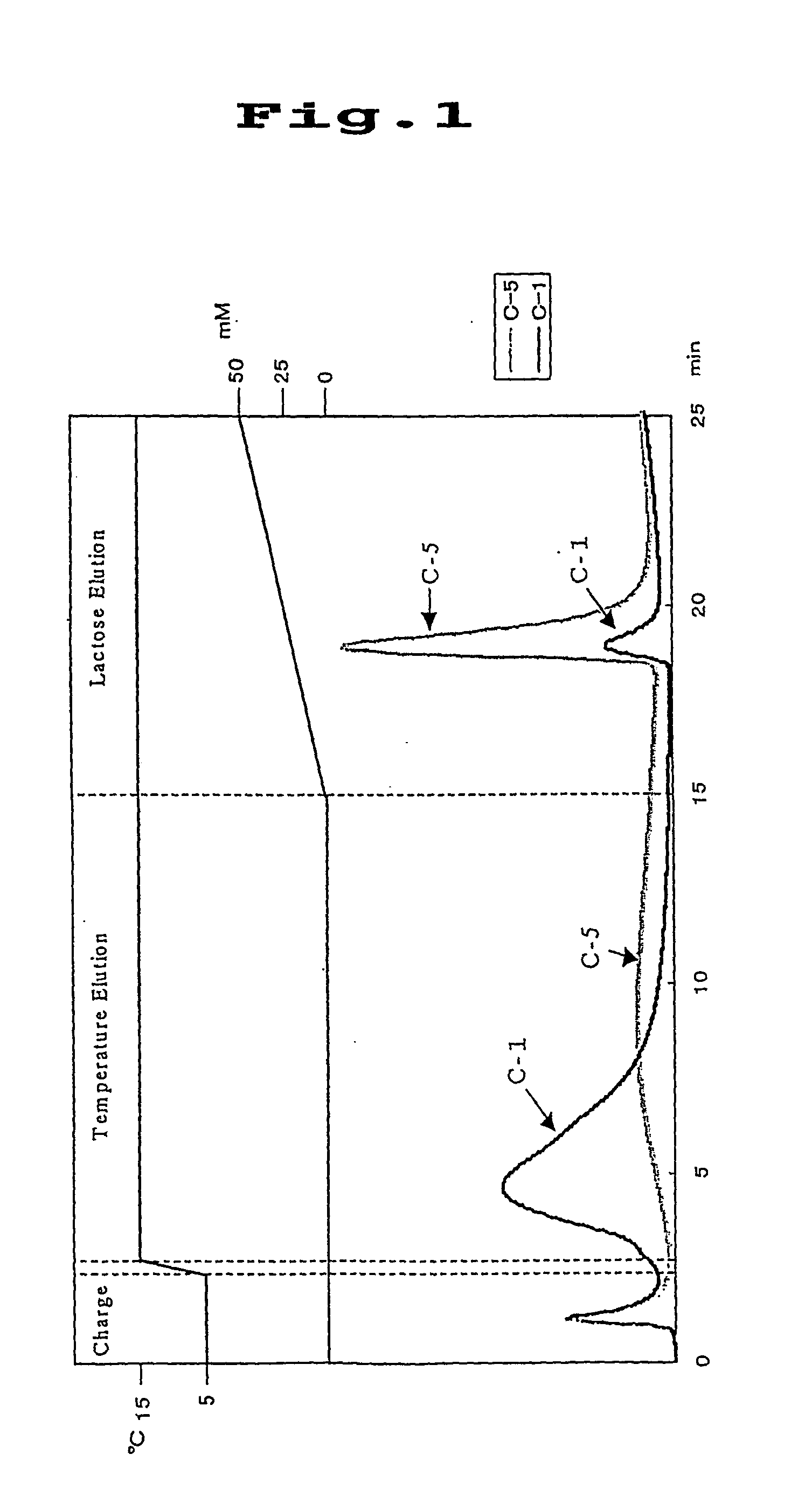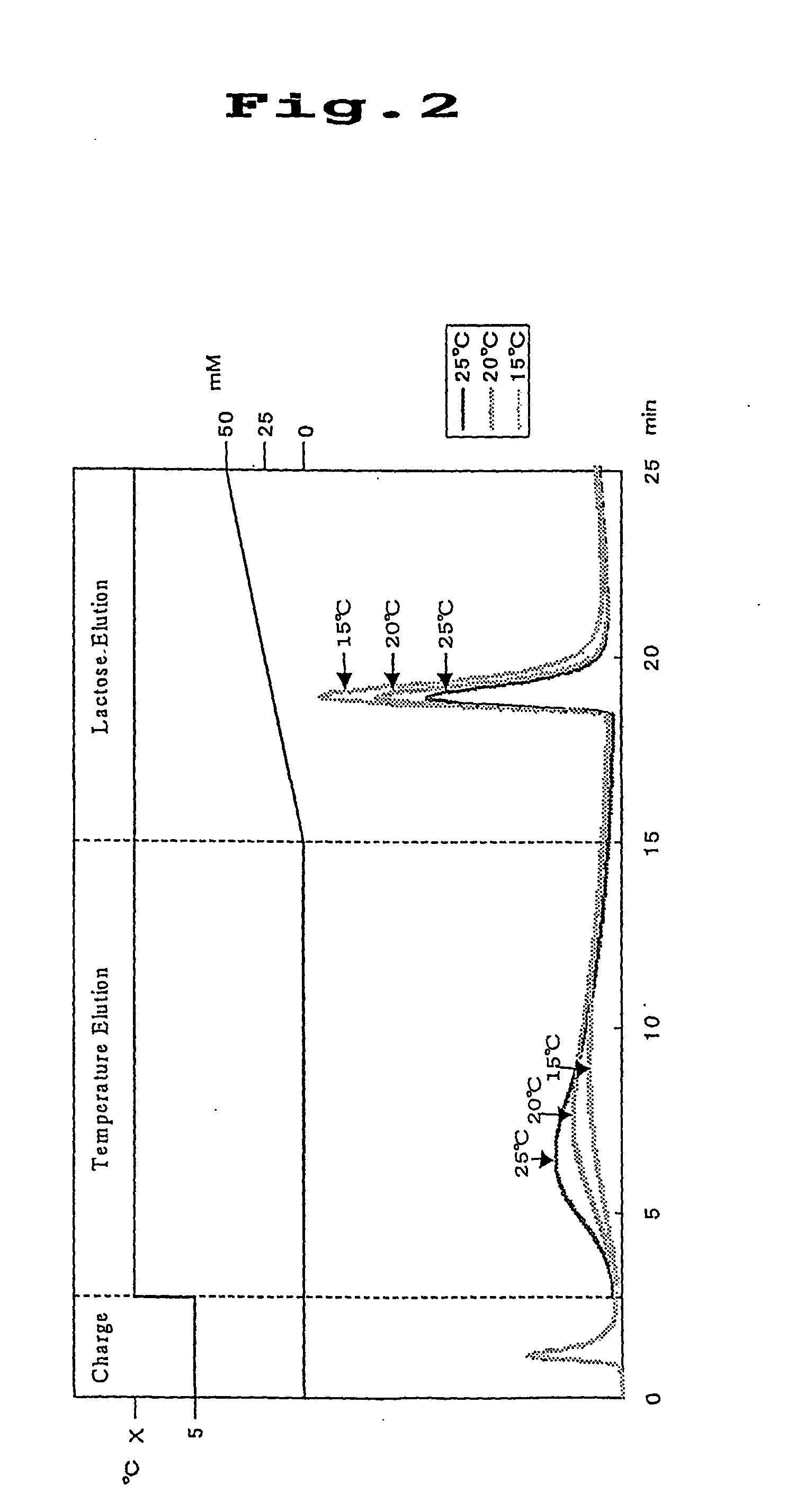Stimulus responsive affinity chromatographic material and separation/purification method
a technology of affinity chromatography and chromatographic material, which is applied in the separation/purification of components, chemical/physical processes, peptides, etc., can solve the problems of reduced recovery, reduced recovery, and difficulty or sometimes impossible to separate the target substance from the substance used in the elution
- Summary
- Abstract
- Description
- Claims
- Application Information
AI Technical Summary
Benefits of technology
Problems solved by technology
Method used
Image
Examples
preparation examples
Separation Material Preparation Examples
[0073] Separation materials preparation examples were given below when Ricinus communis lectin (RCA 120) was used as the lectin; lactose was used as the hapten sugar for the RCA 120; and Sepharose was used as the separation material.
[0074] The lactose was reacted in an ammonium bicarbonate saturated aqueous solution for 48 hours and converted into .beta.-lactosylamine.
[0075] After dissolving N-(acryloyloxy) succinimide (6.30 g, 37.2 mmol) and AIBN (50 mg) in benzene (450 ml), polymerization reaction was carried out at 60.degree. C. for 24 hours. After completion of the polymerization, reprecipitation from tetrahydrofuran (THF) was performed to obtain poly(N-acryloyl succinimide) as a white polymer (6.12 g, 98%).
[0076] EAH Sepharose 4B (Amersham Pharmacia Biotech) was used as the separation material.
[0077] Further, an NHS-activated Hi-Trap Column (1 ml) (Amersham Pharmacia Biotech) was used as the prepacked column.
preparation example 1
[0078] After dissolving poly(N-acryloyl succinimide) (1.0 g), isopropylamine (314.8 mg) and .beta.-lactosylamine (10.1 mg) in 3 ml of dimethylformamide (DMF), the mixture was stirred at room temperature for 36 hours to effect reaction. After completion of the reaction, the polymer was subjected to reprecipitation to obtain a white water soluble polymer (0.81 g). This water soluble polymer was reacted with RCA 120 in PBS buffer (pH 7.2) in the presence of lactose. (10 mg) at 4.degree. C. for 12 hours, and then the reaction solution was introduced into a column (1 ml) packed with EAH Sepharose 4B to effect immobilization reaction at 4.degree. C. for 6 hours. After completion of the immobilization reaction, 1 ml of PBS buffer solution containing ethylenediamine (0.01 mg) was introduced thereinto and after the column thus prepared was left to stand at 4.degree. C. for 12 hours, the remaining succinimide groups were inactivated with an ethanolamine solution [prepared by dissolving ethano...
preparation example 2
[0079] After dissolving poly(N-acryloyl succinimide) (1.0 g), isopropylamine (314.8 mg) and .beta.-lactosylamine (50.5 mg) in 3 ml of dimethylformamide (DMF), the mixture was stirred at room temperature for 36 hours to effect reaction. After completion of the reaction, the polymer was subjected to reprecipitation to obtain a white water soluble polymer (0.81 g). The water soluble polymer was then reacted with RCA 120 (5 mg) in PBS buffer (pH 7.2) in the presence of lactose (10 mg) at 4.degree. C. for 12 hours, and then the reaction solution was introduced into a column (1 ml) packed with EAH Sepharose 4B to effect immobilization reaction at 4.degree. C. for 6 hours. After completion of the immobilization reaction, 1 ml of PBS buffer solution containing ethylenediamine (0.01 mg) was introduced therein and after allowing the column thus prepared was left to stand at 4.degree. C. for 12 hours, the remaining succinimide groups were inactivated with an ethanolamine solution to prepare a ...
PUM
| Property | Measurement | Unit |
|---|---|---|
| Temperature | aaaaa | aaaaa |
| Concentration | aaaaa | aaaaa |
| Critical solution temperature | aaaaa | aaaaa |
Abstract
Description
Claims
Application Information
 Login to View More
Login to View More - R&D
- Intellectual Property
- Life Sciences
- Materials
- Tech Scout
- Unparalleled Data Quality
- Higher Quality Content
- 60% Fewer Hallucinations
Browse by: Latest US Patents, China's latest patents, Technical Efficacy Thesaurus, Application Domain, Technology Topic, Popular Technical Reports.
© 2025 PatSnap. All rights reserved.Legal|Privacy policy|Modern Slavery Act Transparency Statement|Sitemap|About US| Contact US: help@patsnap.com



